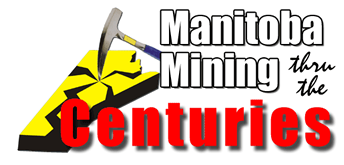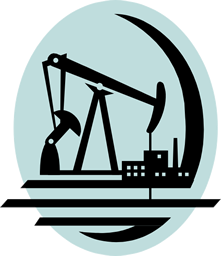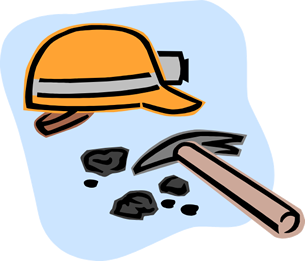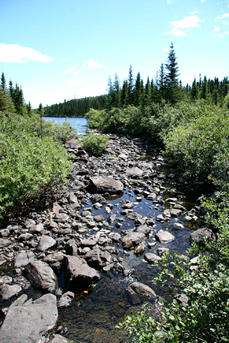| HOME | KIDSROCK | TEENSROCK | GEOTOURS |

| History of Rock |
Exploration and Mining |
Directions | Opportunity Rocks! |
GeoTours | Legends of Rock |
Geology FAQs |
More to X-plore! |
Geo-Links | Explore Manitoba |
If you think mining is all about building a mine and working underground, get ready to learn more. Today’s modern mining is a highly-advanced and technologically-progressive industry. Mining is about much more than finding and unearthing resources. Modern mining focuses on sustainable development and sound environmental practice. It’s about building communities and advancing the future.
Mineral Resources in Manitoba
To make the most of our resources, Manitoba Business, Mining, Trade and Job Creation is helping the province’s economy to grow for the future through its professional service branches.
What Do Geologists Do?
Manitoba’s geologists may work in a number of capacities, including mineral exploration. Learn about the work done by a Mineral Exploration Geologist and explore more about geology careers at Opportunity Rocks.
Manitoba Mining Facts
The mining and petroleum industries are Manitoba’s 3rd largest primary resource sectors.
Mining is a technologically-advanced industry.
Mining is one of the most highly skilled and highest paying industrial sectors.
Mining industry opportunities involve over 120 different careers.
The mining industry has a strong commitment to sustainable development practices that protect the natural environment and respond to the needs of local communities. (Source: MiHR)
What’s Mined Where?
 |
Manitoba has had a long and prosperous history in the world of mining, including a long list of companies doing business in the province's mineral and petroleum industries. The Manitoba Mining Thru the Centuries website presents the history of mining in the province as a timeline and includes a provincial map showing mining locations both historical and current, commodity information, company listings and a photo gallery. |
Mining 101
Mining involves four key phases or steps: Exploration, Development, Production, and Reclamation and Closure.
Exploration Exploration is all about the quest for resources. Mineral exploration is the key activity which leads towards the opening of a mine. In fact, mining would not exist without the important ‘groundwork’ of exploration. The primary purpose of exploration is to locate new sources of base and precious metals such as nickel, copper, zinc and gold, and specialty metals such as cesium. In addition, exploration may lead to the discovery of industrial minerals such as dolomite, spodumene, silver, gypsum, salt, granite, limestone, lime, sand and gravel. Manitoba mineral resources with potential for future economic development include diamonds, platinum-group elements (PGE), rare earth elements (REE), titanium, vanadium, chromite, silica and potash. Geologists and prospectors explore for evidence of these materials. Once evaluated, these mineral resources may have potential to be developed into an economically-viable deposit which can be mined or extracted. |
|
Three types of mineral exploration:
‘Grassroots’ or early exploration involves searching for a mineral deposit in an area that hasn’t been searched before.
‘Brownfield’ exploration involves a search for additional deposits near a known mine.
‘On-site’ mineral exploration is an expanded search for a mineral resource that has already been found and developed on the property of an existing mine.
1 in 10,000!
The success rate for ‘grassroots’ exploration is very low. Many mineral showings need to be closely examined to discover a deposit that can be developed. Fewer than 1 in 10,000 mineral showings actually move on to become a mine.
Exploration often means spending a good deal of time and money in the search for mineral deposits. For exploration projects where a promising mineral showing exists, it can take 7 to 10 years before the start-up of a new mine, or it may take longer depending on factors such as the investment which may or may not exist to support such a project. In short, developing a mine may take several years and several million dollars worth of exploration work before a discovery is made. It may require added time and money before a working mine is fully developed to become operational.
Development Mine development involves the process of determining the potential value of a mineral deposit and whether or not the deposit can be profitably mined to benefit the mining company and the region. Many factors must be considered by a mining company before moving ahead with development and operation. In order to build a mine a deposit must be large and valuable enough to cover costs of construction (capital costs) and costs to run a mine (operating costs). Development activities may include the following: Drilling, sampling, field tests, and collecting technical, environmental and other information to increase the mining company’s knowledge about the resources; Developing a mine plan; Mining company discussions (consultation) with government and communities. |
|
Production/Operation
Mine operation takes place when the process of producing a mineral product begins. Operations get underway when earth and/or rock are taken out of the ground (excavated) and when a processing plant is producing ore (saleable material). The ore is first separated from surrounding rock which is not saleable (waste rock). The operating life of a mine can be as short as a few years or may last for several decades. Operations and shipments from a mine can vary from seasonal to year-round.
The main players in a mining operation can be diverse and may include junior and senior exploration companies, consulting firms, equipment suppliers and manufacturers, construction companies, governments, service providers, financial institutions, industry associations. In addition, schools, post secondary education firms, and community and economic development groups may work closely with industry to help build awareness about mining-related careers and opportunities.
Mine Closure and ‘reclamation’ Mine closure involves the ‘reclamation’ or renewal and restoration of mined land as closely as possible to its original condition, following the conclusion of all mining in an area. No matter how long mines may operate, all mines eventually have an ‘end date’ or closing date. Mines often close for different reasons, but most commonly the reason for closure is because the operations site has run out of a particular resource that was being mined. (For example, lower demand for a resource may have led to lower metal prices, making it to costly or uneconomical to continue to run the mine). Restoring a mine site must take place according to government regulations. Many times, environmental activities continue long after a company has finished mining an area. A mining company is obligated under permit or licensing conditions to reclaim affected land and to monitor the success of reclamation activities. |
|
Types of Mining
Underground, Open Pit and Surface Mining
Underground mining may take place following the evaluation of an ore body which can involve drilling for samples of ore over several years. Once a valuable ore deposit is located, the resource may be mined by sinking a shaft or by open pit excavation. To start a mine shaft, a ‘headframe’ is built to hold the equipment and machinery to access the ore and to move the ore and workers from the ore body location to the surface. Each portion where ore is removed is called a ‘stope’. Once ore is brought to the surface, it is sent to a mill where the valuable mineral is separated from waste, and concentrated. Minerals such as copper, zinc or nickel can be found in underground mines in northern Manitoba communities like Flin Flon, Thompson, and Snow Lake.
If an ore body is near the surface of the land, a mining company can use an open pit or surface mining method of extracting it. Open pit mines or ‘quarries’ are created by digging into the ground (or excavating), leaving benches or ledges. As is the case with underground mining, steps are taken to develop the site to minimize environmental impacts and to work within regulatory guidelines and legislation.
Manitoba Mines & Minerals Act
The Manitoba Mines and Minerals Act and other Acts and regulations have been put in place in order to help provide society with mineral needs and to respond to resource demands, while at the same time ensuring that important rules are in place to govern the mining industry, the environment, and other mining industry-related activities.
Orphaned and Abandoned Mines
Orphaned and abandoned (O/A) mines are mines for which the owner cannot be found or is financially unable or unwilling to carry out site renewal or rehabilitation. O/A sites exist within all mining jurisdictions in Canada.
Why do O/A mines exist?
Many existing O/A sites were developed decades ago before the effects of mining or potential environmental impacts from mining were fully understood and before modern-day operating standards were developed.
Why should O/A mines be restored?
Some O/A mines may pose environmental, health, safety and economic risks to communities and may impact the mining industry and governments. Manitoba has committed millions of dollars for the restoration of orphaned and abandoned mines through its Orphaned and Abandoned Mine Site Rehabilitation Program.
The importance of restoration
Mine site restoration (rehabilitation) is an important and responsible action which is taken in order to close former mine sites by identifying and correcting any safety hazards, managing the disposal of potential hazardous and toxic substances, eliminating contamination in the air and water, and returning the land as close as possible to its natural state.
Green Mining
Modern mining involves a focus on the balancing of the needs of industry and communities. A modern mining approach includes the restoration (rehabilitation) of communities and areas where mining once took place, such as at orphaned and abandoned mine sites. Modern or "green" mining is important for long-term sustainability of both the land and community where mining takes place. It’s about taking care of the earth while benefiting from and enjoying its resources. (![]() , 7:43).
, 7:43).
'Black Gold’ – Manitoba Petroleum
What is oil? Oil and natural gas together make up petroleum (a word taken from the Latin language meaning ‘rock oil’). Both oil and gas are non-renewable resources. Petroleum is made up of decomposed former plant and animal life which was compressed for many millions, even billions of years. When oil comes straight out of the ground as a liquid it is called ‘crude oil’ if it is dark and sticky. Crude oil that evaporates quickly is called ‘light’ oil. Crude oil that doesn’t flow easily is called ‘heavy’ oil. ‘Sweet’ crudes are oils that are easy to refine because they contain little sulphur. ‘Sour’ oils contain more sulphur and require more processing. |
 |
Ancient History
For thousands of years, people used ‘rock oil’ for energy after discovering that a black sticky pitch or tar substance found in the earth (bitumen) could be used to waterproof their homes from floods or to seal a broken piece of pottery. For many years in the ancient world, oil was distilled for use as kerosene or lamp oil.
Concentrated Energy
It is only in the last century that oil and gas have become major and important energy sources. Today you could probably say that petroleum, like the minerals we value and use daily, makes the world go around. Oil contains mostly the elements hydrogen and carbon, which combine in oil as chemical compounds or hydrocarbons. Oil’s energy is stored in these bonds that hold its hydrocarbon molecules together.
There is enough energy in one barrel of crude oil (158.99 litres) to boil about 2,799 litres of water. That’s a whole lot of water, and it goes to prove that one barrel of crude is a barrel of highly concentrated energy, and it is energy that helps run our lives.
Gas produced from crude oil (unprocessed liquid oil) powers cars we drive, jets and aircraft we fly in, ships, trains, and semi and tanker trucks, and more. Natural gas is used to generate electrical power and oil is also a raw material from which many modern-day substances such as most plastics are made.
Manitoba Oil
Two-fifths of the Precambrian basement in Manitoba is covered by sedimentary rock, and some of the province’s sedimentary rock contains oil. Oil was first discovered in Manitoba near the town of Daly, and was produced in Manitoba in 1951.
Manitoba has two potential areas for oil and gas production, southwest Manitoba and the Hudson Bay lowlands.
There are approximately 3,040 oil-producing wells in Manitoba. The current cost to drill and complete a well in Manitoba ranges from $325,000 to $1.2 million, depending primarily on depth. Since 1951 over 315 million barrels or 50 billion litres of crude oil have been produced from rock formations underlying southwestern Manitoba. In 2012, about 17.1 million barrels or 2.7 billion litres of oil (48,835 barrels per day) were produced from porous limestone and sandstone formations at depths of up to 1 kilometre.
Approximately 80% of the oil and gas rights are owned by private individuals or companies (freehold), while the remaining 20% are owned by the Crown (in the right of Manitoba).
Manitoba's petroleum industry provides jobs for many residents in the region, particularly from the towns of Virden, Melita, Waskada and Pierson. Visit the Petroleum Branch's website for more information on Manitoba's petroleum industry.
References:
Mining Information Kit for Aboriginal Communities: Exploration, Development, Operation, Closure, Government of Canada 2006
Explore for more...



